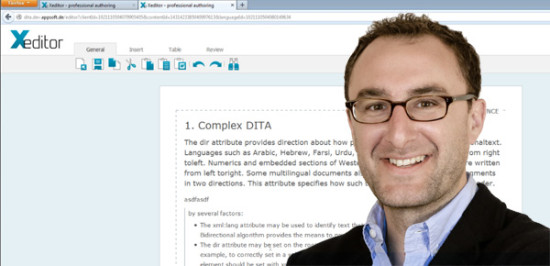
Recently I was made aware of a new online-based XML editor: Xeditor. Developed by appsoft, it is a web browser-based works XML that works with DITA and other XML standards. I was given a demo of the product by Anthony Apodaca and developer Thomas Werzmirzowsky, demonstrating to me that it is another potential tool content creators working with DITA might want to add to their set of tools.
After the demo Anthony kindly agreed to an interview for publication on DITAWriter. Here it is:
DITAWriter: Could you give me an overview of what Xeditor is and what it does? Does it work with DITA?
Anthony: Xeditor provides authors with an intuitive experience for creating structured XML documents without requiring any technical knowledge of XML. It is a web-based XML editor so there is nothing to install and our latest version also has an offline mode.
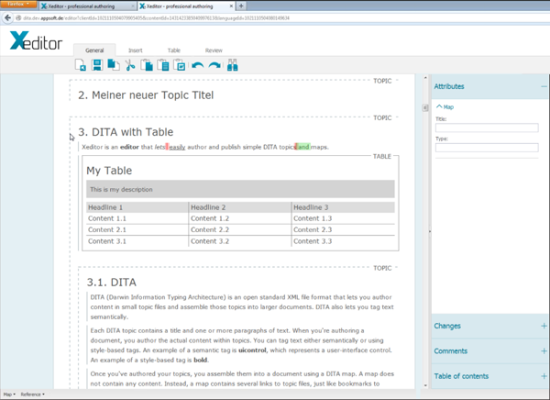
We place a great value on the user-experience because the benefit of such a tool only reaches its true potential if people really enjoy using it. Writing, for any type of publication, is a lot of work and demands are on the rise for structured single-source content and multi-channel publishing. So we want to provide authors with a tool that helps them manage the writing process in that type of environment. We also want to make sure that developers enjoy the tool as well, so it is completely configurable and extensible for easy integration with other systems.
In addition to DITA support we also support standard data models like PI-Mod and DocBook as well, with support for TEI and NLM/JATS coming in the near future.
DITAWriter: How did the idea for Xeditor come about? Who are your customers?
Anthony: The idea for a web-based XML editor came about while we were working on an overall publishing suite. We noticed that many customers already had tools, systems, and workflows for managing and delivering content that, for better or for worse, were not going to be replaced any time soon. So in developing Xeditor we were able to offer a user-friendly way to create and edit content without disrupting how it was managed and delivered.
Right now, we have customers across different sectors, including universities, technical publishers, and traditional publishing houses offering legal or academic content.
DITAWriter: I understand that Xeditor doesn’t have a “tag level” or “code view”. How does it tell users what tags are being used when they add content? How do users insert DITA tags?
Anthony: In order to keep the user-interface clean and simple we offer several alternatives to viewing/editing tags. However, if a tag view was a requirement for any customer, it would be no problem for us to implement it on request. Otherwise, there are three main methods that cover this functionality.
First is in the text itself, where formatting is used to make the tag visually distinct and where the user can right-click anywhere to see the current tag and get a menu to insert any valid tag. The formatting here is controllable and customizable via CSS and allows us to, for example, display orange highlighting for a DITA “note” tag with a “warning” attribute and a red tag if the attribute reads “danger”.
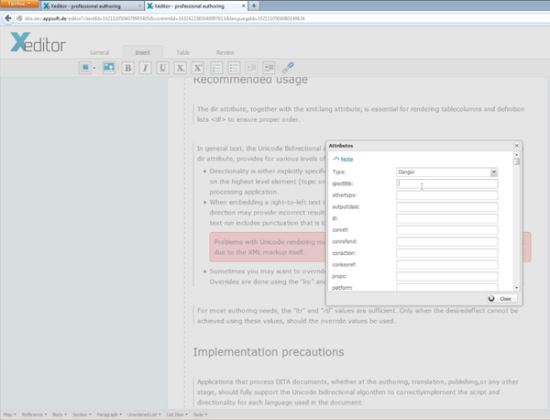
Second is the ribbon at the top of the editor, which allows users to insert any element by clicking on the icon. The options are contextual so the icons will not be available if, for another example, a bold tag is not allowed in a heading.
Third, there is a bread crumb trail at the bottom of the editor that always displays the path of the current cursor location. Here you can click on any of the tags in order to either change the current tag or insert another valid tag.
Lastly, we have an accordion on the right panel that displays the attributes of the specific tag based on the location of the cursor. The user can edit these attributes directly in this panel. All of these options are completely customizable depending on the data model and may also be configured for different user groups.
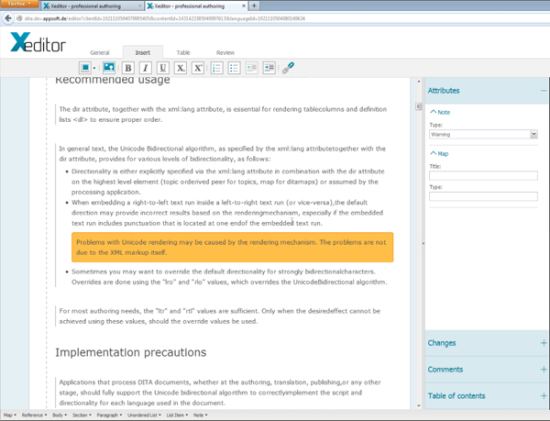
DITAWriter: How does Xeditor deal with DITA maps and associated topics?
Anthony: Xeditor can easily process large maps containing more than 1,000 topics. The topics can be edited independently or in context with others in a map. Drag-and-drop functionality is available in the table of contents so that the order of topics within a map can easily be changed.
DITAWriter: I understand Xeditor has a change tracking feature. How does that work?
Anthony: When track changes is turned on (via the “Review” option in the top ribbon), any additions will be highlighted in green and any deletions marked in red. Users navigate the changes in the right panel, where each is listed separately along with the user that made them. And you can also skip forwards and backwards through the changes via buttons on the top ribbon.
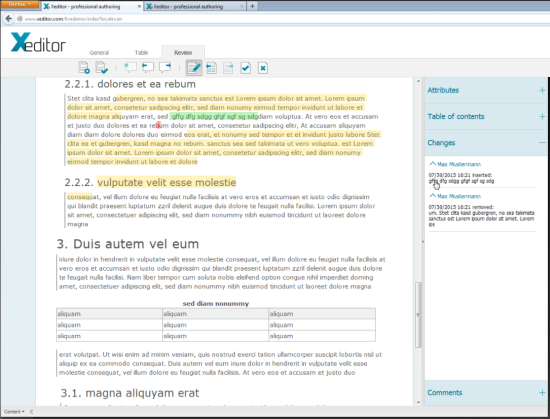
DITAWriter: How would a user output their DITA content from Xeditor? (In other words, how do you “print” from Xeditor?).
Anthony: One of the great features about Xeditor is that it does not dictate this part of the process. As I mentioned above, we took great care to create an XML editor that is agnostic to pre-existing tools/systems and workflows. The core code of Xeditor is designed simply and only to be an editor that takes XML as an input and delivers it as a result. This concept combined with our API allows our clients to create load and save options that can be written in any programming language and therefore it is virtually unlimited in how you can process the file post-Xeditor. We do have a separate product called Xpublisher, which incorporates the editor into a full publishing suite.
DITAWriter: Does Xeditor work with any Content Management Systems?
Anthony: Absolutely – as long as the CMS is online! Xeditor really is meant to a light-weight tool expressly for the purpose of editing XML. Any programming language may be used to write the integration with the CMS, and the only requirement for Xeditor is that it is a valid XML file against the configured schema.
DITAWriter: There seems to be a trend towards moving XML editors to the web. Why do you think that is and are they intended to replace standalone, desktop XML editors?
Anthony: Our clients want to provide their authors with the easiest way to edit XML–especially authors with no knowledge of XML. With web-based editors there is nothing to install, nothing to configure, and they work well on multiple devises and platforms. The latter is important because a lot of authors are not internal users and may be working on a variety of systems. The biggest drawback with this type of software is that it usually requires an Internet connection, but Xeditor allows for this since our last release.
I do not think Xeditor is intended to fully replace desktop editors, as there are different scenarios for their use, such as for internal users and developers. Some of our clients have actually implemented Xeditor alongside desktop editors (even non-XML based); it really depends on what our clients need and how their authors are interacting with the content.
For more information about Xeditor, see their website at: www.xeditor.com. Many licensing options are available; contact Anthony Apodaca at: apodaca@appsoft.de.

One thought on “Interview with Anthony Apodaca about Xeditor”
Comments are closed.